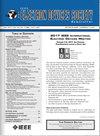基于单晶LiNbO₃薄膜的忆阻器非理想因子的现象学建模
IF 2.4
3区 工程技术
Q3 ENGINEERING, ELECTRICAL & ELECTRONIC
引用次数: 0
摘要
忆阻器作为一种新型器件,因其在神经网络计算中的潜力而备受关注。然而,忆阻器的非理想因素,如电导漂移和编程误差,限制了它们在实际应用中的性能。单晶LiNbO₃薄膜忆阻器(LN忆阻器)具有良好的神经网络计算性能,但关于该忆阻器非理想因素的研究很少。本文旨在对LN忆阻器的这些非理想因素进行建模,并探讨这些非理想因素对基于忆阻器的神经网络计算的影响。从制备的LN忆阻器中提取了关键的非理想参数,建立了唯象模型。模型结果与实测结果吻合,证明了模型的有效性。我们将这些模型嵌入到器件仿真平台中,以评估不同非理想因素对基于忆阻器的神经网络的影响。该研究提供了一种有效的方法来模拟LN忆阻器的非理想因素,可以准确地捕捉LN忆阻器在实际应用中的复杂行为。此外,通过建模和分析,研究人员可以更好地了解LN忆阻器的机理,从而优化忆阻器设计,提高神经网络计算的忆阻器性能。本文章由计算机程序翻译,如有差异,请以英文原文为准。
Phenomenological Modeling on the Nonideal Factors of Memristor Based on Single-Crystalline LiNbO₃ Thin Film
As a novel device, memristors attracted great attention because of its potential in neural network computing. However, the nonideal factors of memristors, such as conductance drift and programming errors, limit their performance in practical applications. Single-crystalline LiNbO₃ thin film memristor (LN memristor) exhibited good characteristics for neural network computing, but few work about the nonideal factors of the memristor has been reported. This work aims to model these nonideal factors of the LN memristor and explore the influence of these nonideal factors on the memristor-based neural network computing. We extracted key nonideal parameters from the fabricated LN memristor and established the phenomenological model. The model results agree with the measured results, which proves the validity of the model. We embedded these models into the device simulation platform to evaluate the effects of different nonideal factors on memristor-based neural network. This study provides an efficient way to model the nonideal factors of the LN memristor, which can accurately capture the complex behavior of the LN memristor in practical applications. In addition, through the modelling and analysis, researchers can better understand the mechanism of the LN memristor, so as to optimize memristor design and improve memristor performance for the neural network computing.
求助全文
通过发布文献求助,成功后即可免费获取论文全文。
去求助
来源期刊

IEEE Journal of the Electron Devices Society
Biochemistry, Genetics and Molecular Biology-Biotechnology
CiteScore
5.20
自引率
4.30%
发文量
124
审稿时长
9 weeks
期刊介绍:
The IEEE Journal of the Electron Devices Society (J-EDS) is an open-access, fully electronic scientific journal publishing papers ranging from fundamental to applied research that are scientifically rigorous and relevant to electron devices. The J-EDS publishes original and significant contributions relating to the theory, modelling, design, performance, and reliability of electron and ion integrated circuit devices and interconnects, involving insulators, metals, organic materials, micro-plasmas, semiconductors, quantum-effect structures, vacuum devices, and emerging materials with applications in bioelectronics, biomedical electronics, computation, communications, displays, microelectromechanics, imaging, micro-actuators, nanodevices, optoelectronics, photovoltaics, power IC''s, and micro-sensors. Tutorial and review papers on these subjects are, also, published. And, occasionally special issues with a collection of papers on particular areas in more depth and breadth are, also, published. J-EDS publishes all papers that are judged to be technically valid and original.
 求助内容:
求助内容: 应助结果提醒方式:
应助结果提醒方式:


